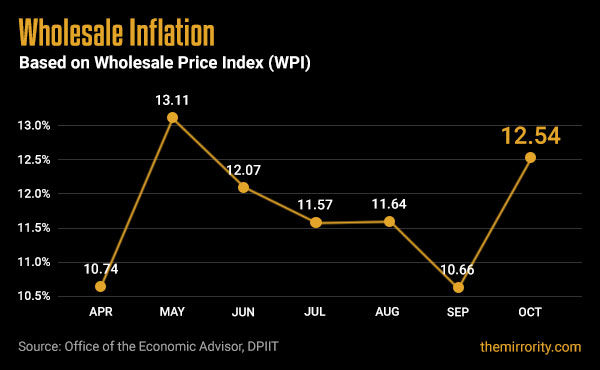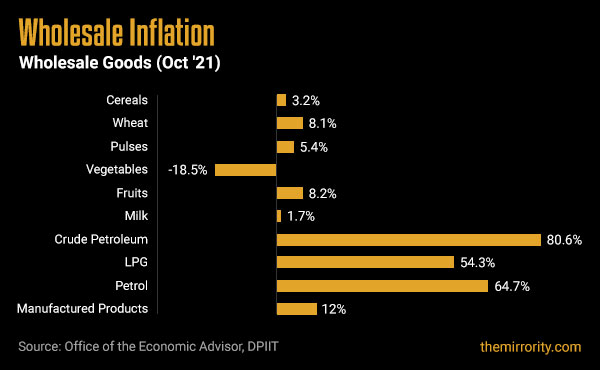
The wholesale price-based inflation, based on the Wholesale Price Index (WPI), spiked to a 5-month high of 12.54% in October 2021. The surge in WPI, which measures what producers charge retailers, follows a rise in retail prices announced 2 days ago.

At 12.54%, the WPI inflation is now just half a percentage point shy of the all-time high of 13.11% recorded in May 2021. The 12.54% surge is in comparison to Oct’20, a Covid-19 pandemic affected month, and hence had the advantage of a low base effect. If compared to Oct’19, the wholesale price-based inflation in Oct’21 is 14.01%.
On the bright side, the consistent rise in wholesale prices is an indication of a rise in demand and growth recovery as the lockdown curbs are eased across the country. This renewed confidence in the economic climate could give further impetus to producers to pass on the higher input and freight costs to the consumers. Since fuel is a major component of the transportation cost, the higher fuel prices are expected to significantly impact the wholesale prices until the effect of tax cuts starts to be seen in the next few months. This, in turn, will lead to a pass-through effect which will see a corresponding increase in retail inflation. While RBI has so far managed to keep interest rates low, it may be forced to tighten its monetary policy if retail inflation rises beyond its target level of 6%.
Given the spike in Covid-19 cases in China, the supply pressure is expected to continue for much longer keeping the wholesale inflation levels high in the near term. According to the data from the Consumer Electronics and Appliances Manufacturers Association, the prices for home appliances and electronics were higher by up to 12% compared to a year ago and weighed heavily on the estimated ₹1.25 trillion on consumer good purchases made during the Diwali period. The supply squeeze has kept prices high in several key global markets, with the US consumer inflation hitting a three-decade high in October.

“The high rate of inflation in October 2021 is primarily due to rise in prices of mineral oils, basic metals, food products, crude petroleum & natural gas, chemicals and chemical products, etc as compared to the corresponding month of the previous year,” the Commerce and Industry Ministry said in its statement.
Crude petroleum inflation was 80.6% during October, as against 71.9% in September. LPG and Petrol price-based inflation was higher at 54.3% and 64.7% respectively. Inflation in manufactured products, the biggest category in the WPI index, touched an all-time high of 12% in October.
The core wholesale inflation touched an all-time high of 11.9% in October. This excludes the generally volatile categories of food and energy and provides a good reflection of how entrenched the current wholesale prices are.
| Also read: Wholesale Price inflation statistics and expert analysis |
Wholesale Food Inflation
WPI has a sub-index called Food Index (WFPI), which is a combination of the Food Articles from the Primary Articles basket, and the food products from the Manufactured Products basket. As a sub-index, it broadly constitutes 24.4% of the overall Wholesale Price Index.

The Wholesale Food Price Index rose 3.06% compared to 1.14% in September
Wholesale prices of wheat were higher by 8.1% while those of fruits were higher by 8.2%. The wholesale prices of some food articles came down as well in October. The wholesale vegetable prices were lower by 18.49% and those of onions by 25.01%.
Reference Reading
What is wholesale inflation?
Wholesale inflation is based on the Wholesale Price Index (WPI) which measures the changes in the price of 697 goods sold and traded in bulk by wholesale businesses to other businesses. Analysts use the numbers to track the supply and demand dynamics in industry, manufacturing, and construction. An upward surge in the WPI print indicates inflationary pressure in the economy and vice versa. The quantum of rise in the WPI month after month is used to measure the level of wholesale inflation in the economy. The wholesale price basket is broadly grouped into Primary articles, Fuel & Power, and Manufactured Goods.
- Primary articles: It constitutes 22.6% of the overall Wholesale Price Index. It is further subdivided into Food Articles, Non-food articles, Minerals, and Crude Petroleum & Natural Gas
- Fuel & Power: It constitutes 13.2% of the overall Wholesale Price Index and tracks price movements in Petrol, Diesel, and LPG
- Manufactured products: This is the biggest component basket and carries a weightage of 64.2% in the overall WPI. It comprises of a variety of manufactured products such as Textiles, Apparels, Paper, Chemicals, Plastic, Cement, Metals, etc and Manufactured Goods such as Sugar, Tobacco Products, Vegetable and Animal Oils, etc.
TO READ THE FULL ARTICLE

Get full access to the exciting content on The Mirrority by logging in
Support independent journalism
Even the very best of media houses in our country today are yielding to the pressure of click-bait journalism in order to survive. More than ever before, our country needs journalism that is independent, fair and non-pliant to the bureaucracy. Such journalism needs the support of like-minded readers like you to help us survive editorially and financially.
Whether you live in India or India lives inside you, help us continue to produce quality journalism with your contribution.
CONTRIBUTE
